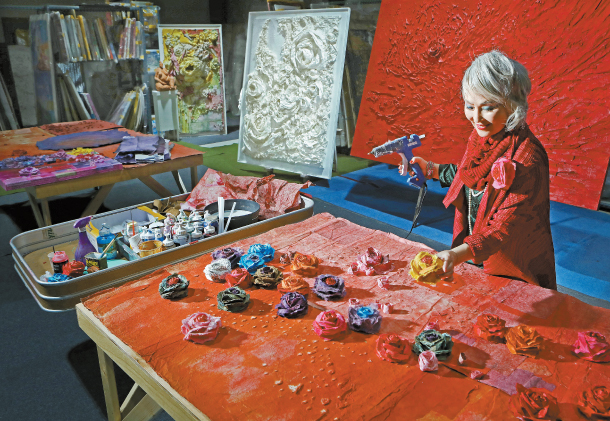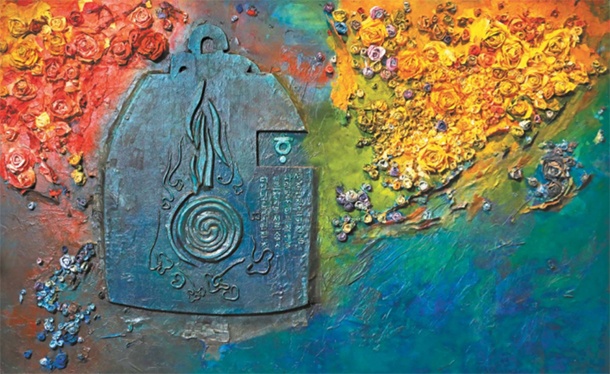[ZOOM KOREA] Crafting paper flowers to show Korea’s beauty

Hanji craft artist Rose Park works on her art pieces which are mostly made with hanji, traditional paper, and roses. [PARK SANG-MOON]
Inspired by her love of flowers, the artist creates her own world using hanji or traditional Korean paper and rose petals. Park says her artworks embody femininity and vitality.
In the realm of her art, Eastern philosophy is represented through the traditional paper while sentiments of the West are reflected through roses. As the two materials are blended with each other, they make one-of-a-kind, 3-D art pieces.
Park has been creating crafts in her own distinctive styles over the past two decades. For the artist, hanji means love, and rose stands for wishes.
Park says hanji resembles Korean women in many ways. The paper is resilient, yet elegant and delicate.
Park grew up watching her mother making crafts with hanji. Her parents were both artists who studied in Japan.

Hanji was part of her life, and Park naturally began to understand the characteristics of hanji as she grew up.
Hanji has been around for 2,000 years. The paper is one of the country’s oldest cultural products that is still in use.
Park believes that the paper is associated with every phase of a Korean person’s life, from the moment they are born to their very last day. The paper is present at every moment, whether people are feeling joy or sorrow.
For example, babies are born in rooms covered in hanji. The paper is dyed with blended soybean liquid. The liquid is dabbed on the paper to make it sturdier.
A geumjul or taboo rope is hung over a gate to protect the newborn and the mother from diseases. Strips of hanji, charcoal, pine tree twigs and red peppers are attached to the rope, which looks like a garland. White hanji is believed to ward off evil spirits.
When the baby grows up and becomes old enough to study, he or she begins to read books made with hanji.
When getting married, a letter known as a sajudanja is sent from the groom’s house to a bride. The hanji document contains detailed information about the groom such as his date of birth.
The letter is kept in the bride’s room until she dies. When she passes away, the hanji document is used for making shoes for the deceased.
White hanji is also needed for ancestral rituals that are conducted for the dead.
Park wants to touch upon the cycle of life through her works. In order to address that message, the artist works to bring things back to life.
The artist knows how to revitalize a rose. Park extracts natural dyes from fallen flowers, and the dyes are used as the main materials for her works.
Over the course of doing so, the rose becomes immortal.
Park dries rose petals by herself. Sometimes she boils the petals or steams them to enhance their original colors. The flowers also go through a fermentation process to extract colors.
The artist makes her own hanji, too.

The piece “The Sound of the Sky” took Park four years to complete. [PARK SANG-MOON]
The ultimate goal that Park wants to achieve through her art pieces is visualizing the beauty and sexuality that women possess within them.
Starting in 2012, Park went a step further and began to add hangul to her works.
From an aesthetic point of view, the Korean alphabet is visually beautiful. When the letters are combined, they could be anything, and their values become infinite.
Park usually adopts hangul from ancient documents such as Hunminjeongeum (the initial name of hangul) or “Yongbieocheonga,” the country’s first document written in hangul. “Yongbieocheonga” roughly translates to “Songs of Flying Dragons to Heaven.”
She intentionally picks rhythmic words. The artist also attempts to transform hangul into calligraphy by decoding and dismantling hangul into creative art pieces.
Some of Park’s fans abroad often say that her works evoke mysterious vibes.
The artist describes her overall work procedure as close to that of bojagi or traditional wrapping cloth.
Bojagi can wrap around anything with its versatility. Park thinks that she represents the culture of Korea and the spirit of this country with hanji and hangul.
The artist aims to create a new genre of art by writing hangul onto hanji and making hanji into flowers. With her art, Park hopes to spread the country’s culture abroad.
“A Borderless Flower” is the title of Park’s signature piece. The title also represents the philosophy of the artist.
A flower is not used to do harm or to attack others. It just makes people smile.
For flowers, borders are meaningless. Only humans care about these lines and confront one another over them.
Flowers created by Park are able to freely cross borders. With those hanji roses, Park hopes to deliver the message that the hanji flowers can eliminate all borders.
Park talks about life and Korean culture through hanji roses. By doing so, she asks us a question: Where are your roots?
BY PARK SANG-MOON [moonpark@joongang.co.kr]










with the Korea JoongAng Daily
To write comments, please log in to one of the accounts.
Standards Board Policy (0/250자)